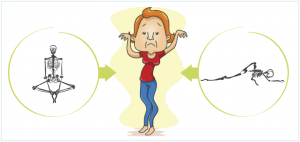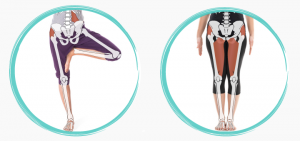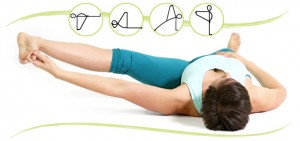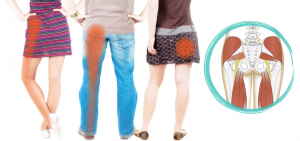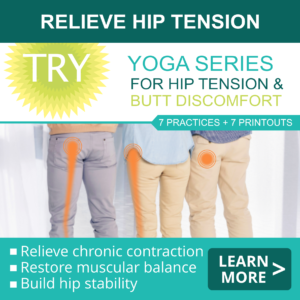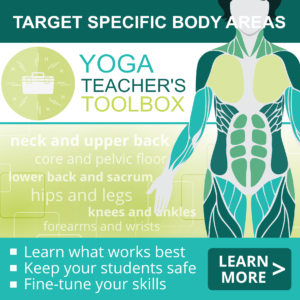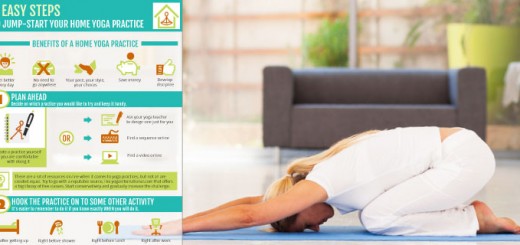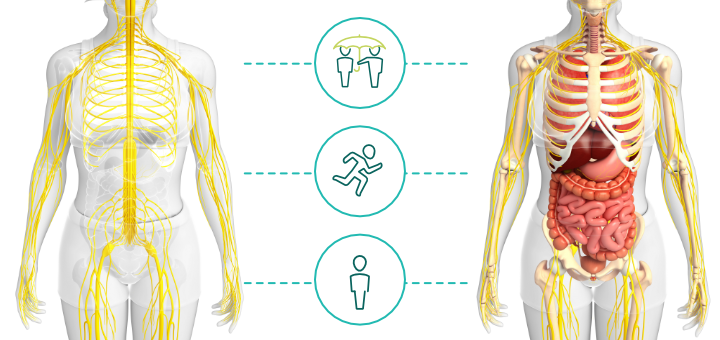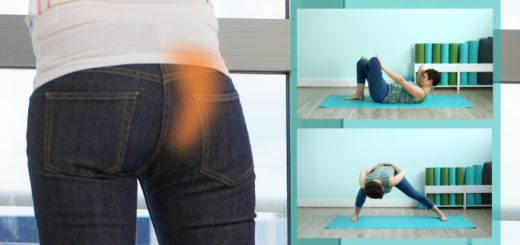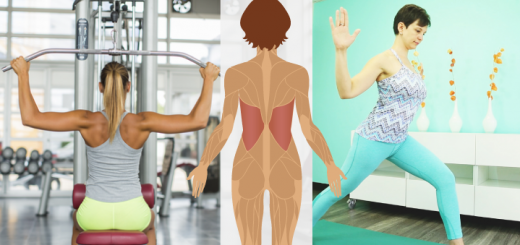
Whenever you plan to work with hip adductors, abductors and rotators in your yoga class or private yoga session, it helps to remember the following important points:
- Your hips usually feel stiff or uncomfortable because of underuse (Ex: sitting too much), overuse (Ex: strenuous hike), or improper use (Ex: carrying baby on one hip). It helps to identify which category your discomfort falls into to develop more precise movement strategy.
- If we want to develop balanced muscular relationships, any stretch we do needs to be supported by contraction on the other side (agonist-antagonist relationship).
- In addition to rotating your hips, your piriformis muscles also support and stabilize your sacrum. This is a delicate relationship and can be easily thrown out of balance if the piriformis on one side gets too tight or too loose. The best way to increase circulation to the area, bring nourishment and develop muscle tone and strength is to contract the piriformis by turning your leg outward against gravity. Abducting the leg works great, too.
- The main job of your hip adductors is to move the leg in toward the midline, and hip abductors to move the leg out. But another important role of those muscles is to stabilize your pelvis when you walk. The imbalance between your adductors and abductors will affect your walking gait and your balance.
- Many people have tight adductors and weak abductors from too much sitting in asymmetrical positions (and other reasons). If we just stretch the inner thighs in our yoga practice by abducting the legs without active engagement of the outer hip, this typical pattern of imbalance will remain largely unchanged. We need to be sure to strengthen the abductors as well.
- “Pelvic opening” poses (where one leg is abducted and rotated outward) are effective for stretching the structures of the pelvis, groin, inner thigh and perineal area, while strengthening the muscles on the opposite side (hip abductors and rotators) to restore balance to the adductor/abductor relationship. Those poses are usually strong and require adequate preparation. To do them safely and effectively first we need to warm up adductors and abductors, then loosen up the hamstrings and inner thighs in the abducted position.
- When you experience discomfort in your buttocks, location of the discomfort can point to the origin of the problem. Injured hamstring tendons will manifest as pain in the crease of the buttock; tight piriformis will show up as discomfort in the middle of the buttock and along the sciatic nerve, and weak hip abductors can cause discomfort in the upper or outer buttock area. Each of those will require a different cause of action.
- It is very useful to do some simple non weight-bearing movements that take the hips through the full range of motion without loading them. This helps to evaluate the tone, agonist-antagonist relationships and relative symmetry of the muscles that move and support the hips. Based on that information we can devise a more effective and safe practice.
Sequence Wiz blog posts about hip adductors, abductors and rotators
Do you prefer “noodle hips” or a spring in your step?
Many students love and request “hip openers” because they feel like their hips are stiff, so stretching them out seems like a good idea. Now let’s take a moment to reflect – why exactly do the hips feel stiff? Usually it happens for one of three reasons. Read more >
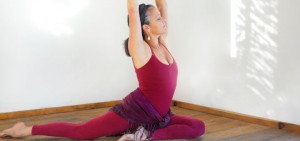 Are we addicted to the Pigeon pose (and other “hip openers”)?
Are we addicted to the Pigeon pose (and other “hip openers”)?
When we talk about hip opening we usually refer to external hip rotation, Pigeon pose and the like. Many students have a love-hate relationship with this pose; it’s the kind that “hurts good”. And after few breaths there, it can facilitate a welcomed release. The question is: how important is that particular pose to the health of your hips? Read more >
Neglecting your hip abductors can mess up your walk, sleep and balance
Whenever you sit with your legs crossed for an extended period of time, you tighten your hip adductors (inner thighs) and weaken your hip abductors (outer hip). As we sit more and more and walk less and less, this pattern of imbalance becomes more common and more pronounced. Let’s explore why the balance between the muscles of the inner thigh (hip aDDuctors) and the outer hip (hip aBDuctors) is important and discuss 6 common misconceptions that we have about those muscles. Read more >
How to prepare for “pelvic opening” poses
The poses collectively known as “pelvic opening” are very useful: they stretch the structures of the pelvis, groin, inner thigh and perineal area, while strengthening the muscles on the opposite side (hip abductors and rotators) to restore balance to the adductor/abductor relationship. Those poses are challenging, but sometimes in yoga classes they seem to pop out of nowhere, without any intentional preparation. Read more >
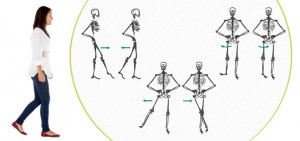 Mighty Tadasana: How to use Mountain pose to train your balance and strengthen your hips and ankles
Mighty Tadasana: How to use Mountain pose to train your balance and strengthen your hips and ankles
While walking seems easy and straightforward (just put one foot in front of the other!), in reality it is a delicate dance between the muscles of the core, hips, legs and feet. We need to keep this relationship coordinated and balanced, otherwise we can’t walk far and without pain. Walking involves shifting the weight to one leg and bearing weight on it while swinging the other leg forward, which means that every potential hip movement is relevant here: hip flexion and extension, hip adduction and abduction, as well as internal and external rotation. Read more >
3 types of pain in the butt and what you can do about it
Having a literal pain in the butt is not a fun experience; it can make walking, sitting and sleeping difficult and uncomfortable. It is certainly something that one would want gone as soon as possible, yet sometimes we unknowingly exacerbate the issue by trying to stretch the injured area. There is a special name for these types of practices – anga bangha. It basically means that you want to do something good but end up hurting yourself. Let’s explore three types of pain in the butt and how you can avoid making your practice anga bangha. Read more >
Assessment yoga practice for the hips
This yoga practice for the hips will help you assess the asymmetries in your hips and give you a better idea of where the imbalances are. It includes Hip Assessment Worksheet that you can use to record your findings. You will have time to record the asymmetries that you observe throughout the practice. Read more >
Sample yoga practices
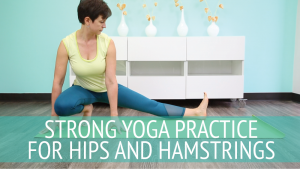 |
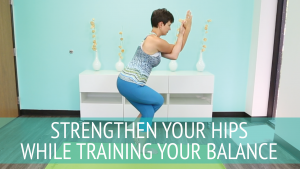 |
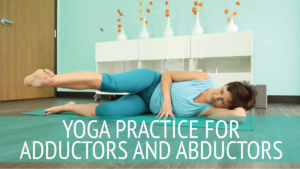 |
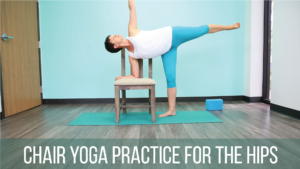 |
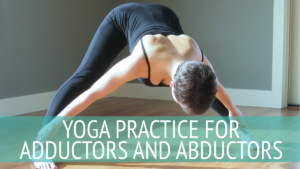 |
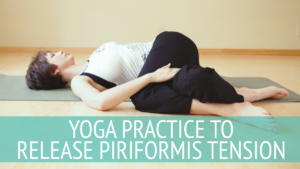 |
Take care of your hips systematically:
6-Week Yoga Series for Butt Discomfort and Hip Tension
In this six-week yoga series we will focus on releasing chronic muscle contraction and restoring balanced relationships between different muscles that move and support the hips.
HOW IT WORKS
Since the hips are weight-bearing joints in your body, the main purpose of this series is to create strength and stability in your hips, so there will be very few “stretchy” movements. Stretching can be counterproductive when we are dealing with chronic muscle contraction, as it can interfere with injury healing and destabilize the joints. Instead, we focus on contracting the structures around the injured areas to increase blood flow, facilitate healing, and develop stability.
As yoga teachers, we want to help our students feel better in their bodies. This means that often we need to work with specific areas of tension and imbalance. What does it take to create an effective practice to release tension and increase range of motion in a particular part of the body? Some principles are universal, and some are unique to the target area. Here are some ideas on how you can approach it in your yoga classes, as well as some safety precautions that we need to consider. Check it out >
[jetpack_subscription_form]

